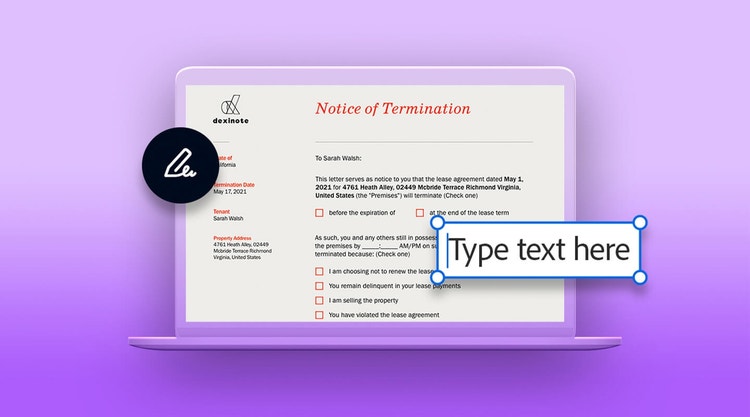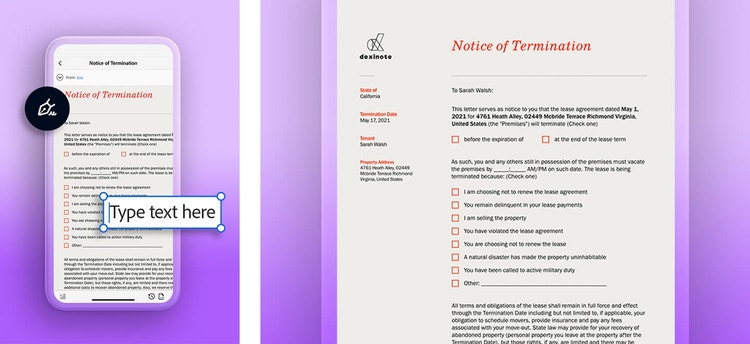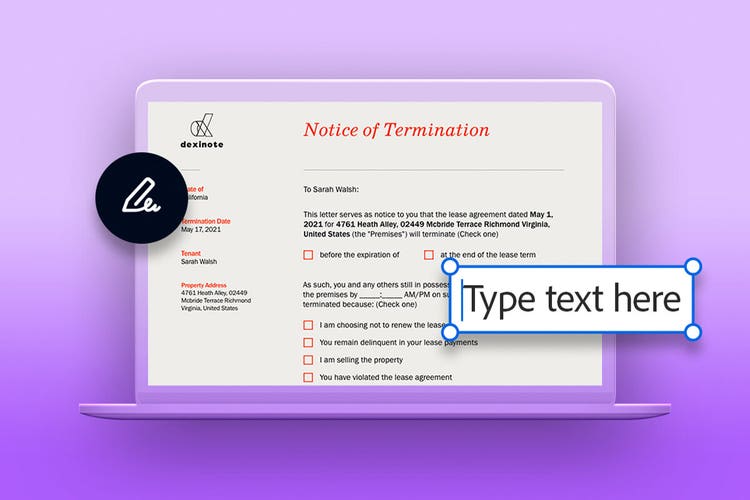ADOBE ACROBAT
How to write a lease termination letter for landlords and tenants.
Whether you’re a landlord or renter who wants to end a lease, learn about termination of lease letters.

What is a lease termination letter?
A lease termination letter is a document used to notify a tenant or landlord that the tenant’s lease will be ending. It clarifies what is expected of the landlord or tenant during the transition. A lease termination letter often includes a deadline for when the tenant needs to vacate the rental property, the reason for the lease termination, and anything that could be done by either party to rectify the situation.
If you need to send a lease termination letter, you should consult an attorney for guidance. Note that a lease termination letter is not an eviction notice. Eviction occurs when a landlord and tenant can’t come to an agreement, and the landlord turns to the courts to force the tenant to leave the property.
When termination of lease letters are typically used.
The lease itself often dictates when a written notice of termination is needed. Both landlords and tenants need to give the other party a notice period before the new move-out date, and the number of days in that period should depend on the specifics of the lease. A 30-day notice is typically required for month-to-month leases, while a 90-day notice is more common for longer leases.

Different kinds of lease termination letters.
Termination of lease letter
A property manager or landlord can write a termination of lease letter to inform their renter that the lease is about to expire or won’t continue after a certain set date. This could happen if the owner is selling the property or the tenant has violated the rules of the lease.
Termination of tenancy letter
If a lease includes a lease termination clause, tenants can choose to end their occupancy early in specific situations using a termination of tenancy letter. Even if there is no lease termination clause, certain situations (such as military deployment) can allow for tenants to end the lease.
Mutual lease termination agreement
If a tenant experiences unexpected changes, such as a new job, divorce, or loss of income, the landlord and tenant can mutually agree to end the lease. Every situation is different, so if you’re a renter, be sure to consult an attorney and understand the lease terms before submitting a lease termination letter.

Typical elements of a lease termination letter from a landlord.
- The landlord’s name and contact information, including phone number
- Name of tenants and their contact information
- The date of the letter
- Reason for lease termination
- Lease start date and end date
- Move-out process instructions
- Copy of the move-out checklist
- Request for the tenant’s new address or forwarding address
- Request for a date and time of walk-through property inspection
A lease termination letter from a tenant who wants to terminate the lease early typically contains much of the same information, along with an acknowledgment that they may owe a penalty for early termination.

Go digital with your documents.
You can manage lease termination letters or termination agreements digitally with Adobe Acrobat Pro. With digital documents, you don’t need to print and mail the letter. Instead, track and update lease agreements digitally or send them as PDFs via email. While lease termination letters don’t usually require a signature, the e-sign feature in Acrobat Pro can let your future tenants more easily sign a new lease digitally.
Landlords and property managers can create lease termination letter templates or lease agreement templates to keep on hand. Save time and easily edit the document whenever you need it.
